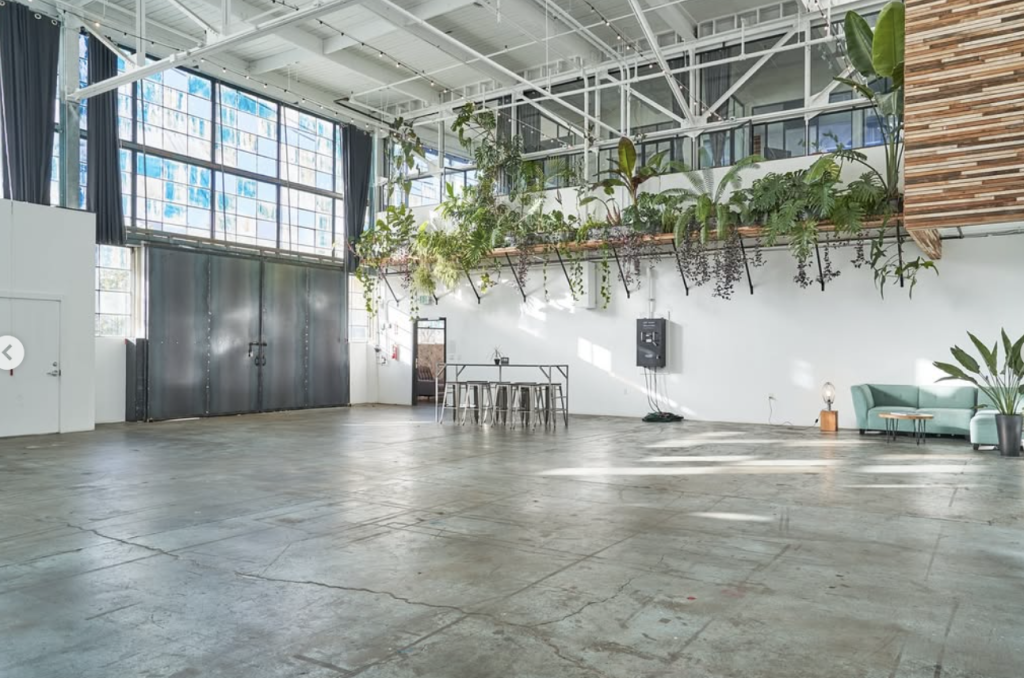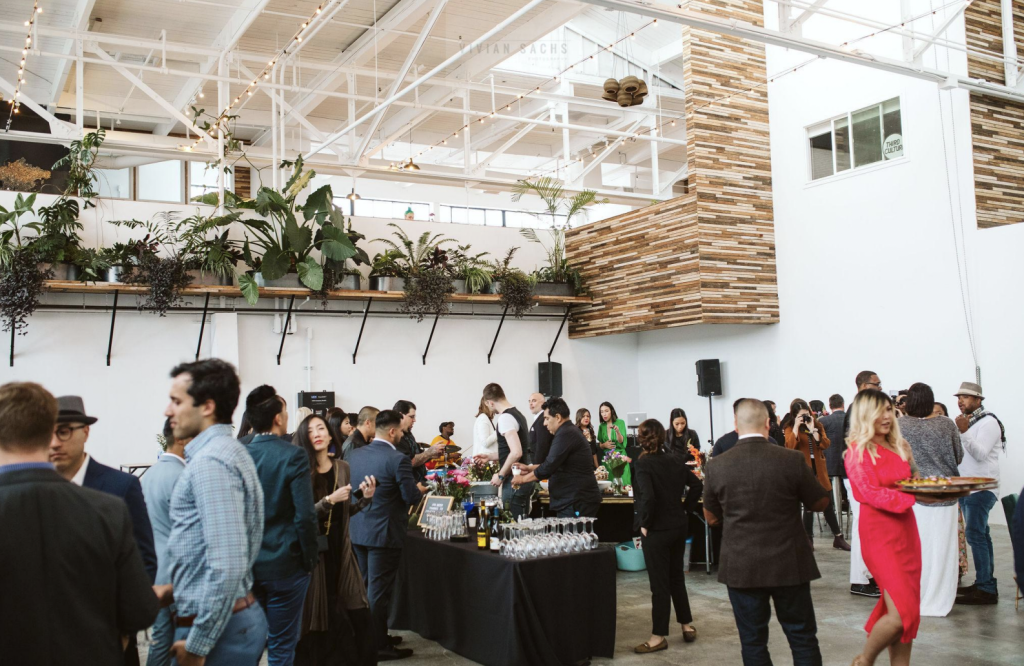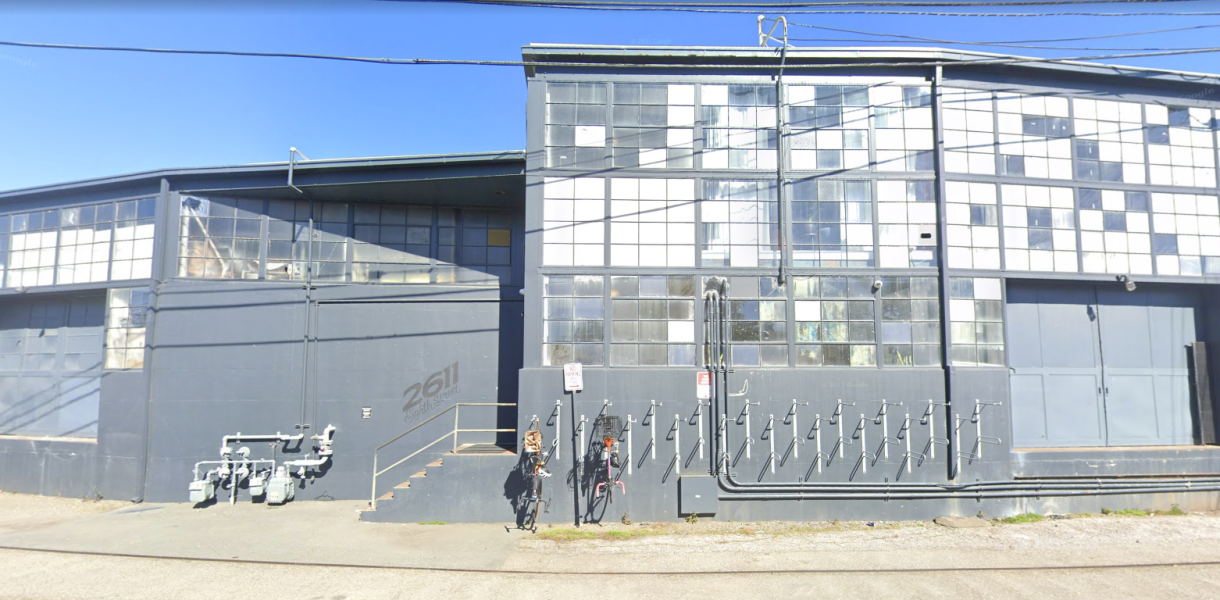Summer 2025 East Bay Open Studios at Ciel Creative Space
The very name “Ciel” for an industrial complex inevitably invokes the lines “reach high” and “the sky’s the limit”… and as the company proudly displays, it has taken its own advice, becoming one of the Bay Area’s Top 50 BIPOC-owned businesses. All the more interesting that its front door is nearly hidden among the façade of its monumental facility, almost humorously found by tracing an arc of temporary marks in the parking lot.

This modesty completely disguises the environment created inside the site, a stunning and strategic blend of Ciel’s three design touchstones: sanctuary, creativity, and productivity.
The Ciel Creative Space website opens up beautifully and dynamically with a tour of what Ciel has built to host its target community: “Ciel is a space by creatives for creatives.” After one tour, even just online, you’re not wondering if you want to be there; you’re wondering how long it will take you to get in there and stay.

A Ciel vision board from 2018: This was written in 2011 after Cecilia gave birth to her second child, Mila Sky. This was her vision for a creative agency and space.
Ciel’s vision of what fosters creativity makes its sheer size far less ironic as it hosts the opening event of the Spring 2025 East Bay Open Studios (EBOS) for individual Bay Area visual artists. That is, while few individual EBOS artists regularly have workspace of Ciel’s scale or scope, the size of their artistic ambition and the dedication to excellence in production is an exact match to what Ciel cares about. EBOS artists often take a space the size of their living room or garage and emotionally transform it into a fully supportive studio of one’s own.
Of course, many visual artists do hold long-term space in lofts set aside for artists. Ciel’s architecture takes its cues mainly from the understanding of psychic space that nearly all EBOS artists have in common. And the Ciel environment directly advocates not just utility but collaboration.
Being literally in the business of creating art, Ciel’s resident and temporary users are accustomed to the range of concerns that were at the origins of Ciel’s development. Among those concerns, Ciel can also boast that it is in the business of creating successful artists as well.
This all but wraps up its natural affinity with the producer of EBOS, Oakland Art Murmur, whose mission is clear:
Oakland Art Murmur (OAM) supports and promotes visual artists and arts venues, and connects the public to the vibrant and eclectic art of the East Bay. OAM envisions an East Bay where visual culture thrives and artists and art venues are sustained through arts-based economic vitality.
As host of the EBOS opening, Ciel especially sponsors two of that mission’s defining aspects: visual culture and arts venues.
Opening the Studios
The salon-style exhibition that opens East Bay Open Studios at Ciel this year surrounds the viewer with multiple constellations of themes, styles, and media. These three distinctions are all characteristics of any work, but the overall organization of works in the show can flow in different ways according to how curating decides to emphasize them. Meanwhile, in the salon setup, the viewer has the most freedom, and sight-lines, to easily perform one’s own additional personal curation, comparing or grouping any of the works – while also appreciating the eclecticism that Art Murmur pursues in its strategic openness and inclusivity within the East Bay.
The show’s audience will be just as diverse, comprising artists, curators, collectors, and the media. In effect, every event participant will be in the thick of the arts ecosystem – convened at a time that likely is the most challenging in several decades when it comes to to the support of the arts.
The Real Thing
With so much being brought together in one location, founder Cecilia Caparas Apelin sat down to talk with us about collaboration, community, and the authenticity of both.
Apelin got right to the point in recounting Ciel’s origin story, rooted in her own personal mission to create a space that greatly expanded opportunity for local artists from her own cultural background (Asian), while growing to reflect a community’s diversity. Connection and cooperation were twin strategies for compatibility, guided strongly by the philosophy of urban acupuncture.
A distinctive effect of that approach is the way Ciel’s model for integrating artist and venue evolves, rather than imposes, its presence in the community, both as a business and as a social force. Featuring artists from both sides of the Bay Bridge, she hosts and amplifies their energy in representing local culture. This stance also highlights that Ciel cultivates its success from the existing local conditions.
The attraction of emulating Ciel’s values is strong, but the possibility of replicating its operating model elsewhere would depend yet again on the special conditions found. An area’s particular socioeconomics would predispose a lot of what opportunity exists, a factor made more complex as those conditions may also be significantly variable there.
Apelin recounted that the creative landscape she began with had been changing since 2008, due to the recession, recovery from which later faced the pandemic and other major issues. As a case of leading by example, Apelin never wavered from her mission and with considerable energy enlisted help in 2015 specifically to generate creative resiliency, a hugely important capability required of the arts community of practice in the next few years now ahead of us.

Built to Inspire
But what would that look like? One of the most important observations Apelin made was that spaces for cultural creativity may be seen as blank canvases to foster community interaction. Given the area’s economics, Apelin leverages the fact that artists energize spaces in ways that attract corporate support, recruiting their creative departments into the mix. In turn that bolsters Ciel’s own capacity to support non-profit and independent artists. Apelin is very sensitive to the large number of empty spaces in the Bay Area and wants to see that untapped resource become available to artists.
Apelin’s personal inspiration is best traced in her own words about its beginnings.
“… Both in and out of my professional life, since basically my early childhood, I’ve worked with and around creatives. My dad is an amazing creative. My mom is a singer. They all have, you know, professional jobs, but they use their creativity in passion projects, and I always thought well, why does it have to be a side project? Why can’t that be the main focus? Growing up, I was very much into fashion art music. And when I got into my early career, it was really in marketing and advertising, understanding those two trades and how they interact, and how there was a way to ignite creativity and find truth and essence in the way that we market and advertise to people. So that’s kind of always been my mission. Now with that said, I would be working in and out of these different studios and I’d go to San Francisco of course, but also travel to LA, New York, a ton, and then even did some global productions out in Asia. And one thing that I very early on noticed is people love creative spaces. They are able to be themselves when they are able to just play.
Run with Advocacy
“Back in 2008, during that recession, I saw a bunch of my creative friends leave the Bay Area. They wanted to find opportunities in LA and New York, which I understood. And it was also at the time where the tech giants were really coming up into the Bay Area and taking on more of that space. But, at that time, I knew I wanted to create a home for creatives. And I was determined to be able to make space for more people like me that look like me, that look like my friends. I already felt this calling to be a host and to be a space holder for creatives.” And from there it would naturally expand its embrace of the community in its location.
Oakland Art Murmur is a happy beneficiary of Ciel’s space, at Eigth Street just below Dwight Way in Berkeley. But while Ciel’s invitation superficially crosses city lines, the regional range of Art Murmur’s mission is most of the East Bay counties; in this instance, through EBOS, Art Murmur extends Ciel’s reach.
“Originally, truth be told, I really wanted to find a place in the industrial part of Oakland. I grew up in Oakland in the early years of my life. My dad used to take me to Lake Merritt and we’d go pick up my mom from Lakeshore Bart. Oakland is part of my roots so this is where we first started looking,” emphasized Apelin.
The search went somewhat on hold while Apelin started a family, raising her children and then returning briefly to the fashion industry. But in 2015, finding a new partner in her creative mission led to Berkeley.
“I absolutely love Berkeley. I used to party it up in my early days, go to Blake’s and Jupiter’s. So when it came to it, I was like, yeah, Berkeley fits all the checkboxes on my list. Based on working in and out of different studios my whole career, I knew I wanted daylight, parking, safety. I really wanted this Bauhaus feel.
“And then we also based it on a philosophy called urban acupuncture… Acupuncture is about the body and releasing tension points throughout the body. So urban acupuncture is about releasing tension points within a city, specifically in a geographical area. We did a lot of research around the socioeconomics within that Berkeley neighborhood, just to make sure that we didn’t disrupt the natural flow of what was happening in that neighborhood, and that our creative space would actually help activate and expand it.”
Looking Forward
As a result of that, Apelin doubled down on what was happening: creative scope.
“I have been thinking about scalability from the moment that we started. I also believe in modularity. I think that we need to be flexible in the way that we use space, which is why it is a creative space that we built. It isn’t just focused on photo and film. It isn’t just focused on events. It really is around art and creators and being a sanctuary for storytellers, underrepresented voices.
“The reason my business model is withstanding through the pandemic and now this recession is we have [ambitious] clients. We work with Fortune 100 companies. They help pay the big bills. I like to operate on the 80-20 rule. So 20% of what we do is to support nonprofits and the arts as a way to give back to our community and create opportunities for corporations to do the same.
And that’s why we’re gonna have Oakland Art Murmur and its amazing event at Ciel this year.”
Getting through the near future is a high priority, one that demands partnering and creating alliances that extend further than Oakland or Berkeley. Apelin and I acknowledged a painful reality: there’s still a disparity between the way that our community works and survives in San Francisco compared to the East Bay.
Said Apelin: “San Francisco is going through a major rebrand, right? And right now, culture and art is needed more than ever. And because San Francisco is the most urban area within the Bay Area, Oakland being right next to it is going to feel the impact of it. A lot of creatives reside in the Bay, but mostly in the East Bay. So, it’s really a mix of bridging the energies of what’s happening in the East Bay and allowing that to flow into San Francisco. I think right now it’s very siloed. It’s very much like San Francisco is doing its own thing. Oakland’s doing its own thing. Berkeley’s doing its own thing. I think we all need to come together to bring up the Bay. Creative spaces also need to be safe spaces for dialogue.”
Interview: Malcolm Ryder with Cecilia Caparas Apelin

